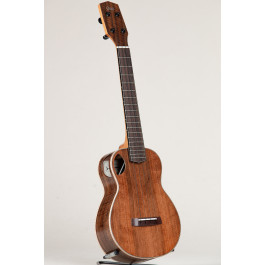I take it as given that the build and tone would be superior, whatever woods were used (my preference might be for a mango top and an acacia body), so I'll concentrate instead on other features.
"Grand tenor" (18.25" scale, body proportionate). I mostly play tenors and baritones, and think my ideal scale would fall somewhere inbetween, favoring the tenor side. I would probably use Bb tuning as my default, meaning that standard tenor sets would work perfectly.
40mm (?) nut: 30mm string spread with a bit extra nut margin on the left side for bending notes without falling off the fretboard.
Cutaway: Venetian or "Art Deco"—no Florentine pointy bit to snag on.
Side sound port
Comfort bevel (angled and rounded edge where the right arm makes contact with the butt).
Pin bridge
Geared tuners: none of that friction or UPT nonsense. I also favor a higher tuning ratio (14:1 or 16:1).
Now we get into trickier waters, because of usage of technologies prone to be proprietary, to rapidly obsolesce or to break or fail—often by design. [Insert diatribe about exploitation, non-sustainability etc.—as if one more would finally spur substantive action.]
Programmable side and face fret markers, defaulting to this pattern: 5, 7, 12, 17. At least two "on" marker colors would be available. The reason markers should be programmable is so that they can be shifted relative to the capo position; sometimes this is appropriate, sometimes not, it depends on how you visualize the fretboard when capoing for a particular song. Also, people have different marker pattern preferences, though mine is the most rational, it goes without saying.
Wireless pickup
Minute sensors for string-to-fret contact, attack velocity and string bend, with a physical string mute (separate) so the fretboard can be used purely as a synthesizer controller. For starters, this would allow entirely remapping the fretboard for any tuning in any pitch register, or imitating a string bass, French horn or Zeldebrian θnörpkΔsl.
All electronics and physical components would be designed for durability. The power would be supplied by an endlessly rechargeable capacitor or the like, proof to leakage. For charging and emergency backup power, there would be a standard phono jack which could be attached to adapters for line power or standard batteries—rechargeable, of course. (This is similar to MiSi pickups.) Of course, if this were a true dream uke, it would be powered by proximity to a directional power field or by a minute dilithium crystal. (The body would also be made of Zeldebrian "koa", which grows like bamboo, has the most exquisite tone and entrancing chatoyance, is proof to temperature changes, and, once treated with mineral oil, is nearly indestructable.)
All components would be made to open, industry-standard specs, meaning that replacement parts would be obtainable from a panoply of sources, not just one who grossly overcharges, or who might go bust or simply discontinue supply at any moment.
In line with that, custom programming and control would be off-instrument. Nothing on the instrument would require periodic replacement, apart from the strings perhaps, while the controller interface and data transfer protocol would follow open-source standards that would remain supported for a lifetime, or at least what's left of mine; after that, I don't care what happens. However, shifting the fretboard markers would be available at all times, including when the instrument was played purely acoustically, with no connection to an external interface.

theukulelesite.com
